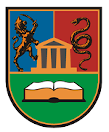Молимо вас користите овај идентификатор за цитирање или овај линк до ове ставке:
https://scidar.kg.ac.rs/handle/123456789/22102Пун извештај метаподатака
| Поље DC-а | Вредност | Језик |
|---|---|---|
| dc.contributor.author | Nikolić, Časlav | - |
| dc.date.accessioned | 2025-02-06T17:02:27Z | - |
| dc.date.available | 2025-02-06T17:02:27Z | - |
| dc.date.issued | 2024 | - |
| dc.identifier.isbn | 9788680596853 | en_US |
| dc.identifier.uri | https://scidar.kg.ac.rs/handle/123456789/22102 | - |
| dc.description.abstract | Noticing that in A Novel of London by Miloš Crnjanski, published in 1971, there is mention of crazy astronomical books, we sought to examine the metaphorical and associative capacity of stars as symbols of orientation in the narrative world. To shape an orientation-focused astropoetics, it was first necessary to illuminate the assumptions of narrative cartography and onto-cartography. Onto-cartography recognizes the symbolic structure of our knowledge about the world as an ecology of loosely interconnected machines linked to other machines, without a central governing principle. We identified the image of the planetarium as the primary example of a discursive machine (and a machine of discourse) that concentrates astral figures and associations in Crnjanski’s novel. Ancient, premodern maps of the starry sky serve as conceptual tools for interpretation, enabling the creation of ephemerides – tables that present astronomical positions from which astrological meanings can be derived. Gaston Bachelard’s mineral cosmology helped us discern the metaphorical derivatives of stars in the novel, represented as gemstones, pearls, rain, and a crystal skull. Following Mircea Eliade’s insights, we aimed to highlight aspects of a possible cosmourbanology, and thanks to Matthew Beaumont’s research on nocturnal walking and the nighttime history of London, we identified a noctivagational horizon in Crnjanski’s novel. All these considerations laid the groundwork to discuss stellar mapping as a dimension where the civilizational skill of orientation manifests. Observing stars as metaphors of orientation contributes to discerning differences among literary works from various eras and understanding the protagonist’s journey as their narrative fate (and, simultaneously, as the ontological expression of an epoch). Through the phenomenon of infinite movement and wandering, one arrives at the hypogeum – an inverted, infernal representation of stars and the sky as plastified constructs. We also paid attention to the conclusion of A Novel of London: the appearance of a pictogram in the form of an asterisk and the figure of a star as the final word in the book. Considering the complexity of the astral symbolism in this work – especially the breadth of theoretical material on astronomy, cultural astronomy, astrology, and particularly astropoetics – we adopted a primary perspective: stars as symbols of orientation. Other ideas related to stars were articulated as contributions to this central line of inquiry. | en_US |
| dc.language.iso | sr | en_US |
| dc.publisher | Faculty of Philology and Arts, University of Kragujevac | en_US |
| dc.relation.ispartof | ZVEZDE: Književna, jezička, umetnička i kulturna astropoetika | en_US |
| dc.rights | CC0 1.0 Universal | * |
| dc.rights.uri | http://creativecommons.org/publicdomain/zero/1.0/ | * |
| dc.subject | stars | en_US |
| dc.subject | astropoetics | en_US |
| dc.subject | orientation | en_US |
| dc.subject | cartography | en_US |
| dc.subject | planetarium | en_US |
| dc.subject | ephemerides | en_US |
| dc.title | ORIJENTACIONA ASTROPOETIKA ROMANA O LONDONU MILOŠA CRNJANSKOG | en_US |
| dc.title.alternative | ORIENTATIONAL ASTROPOETICS IN MILOŠ CRNJANSKI’S A NOVEL OF LONDON | en_US |
| dc.type | bookPart | en_US |
| dc.description.version | Published | en_US |
| dc.identifier.doi | 10.46793/Zvezde24.681N | en_US |
| dc.type.version | PublishedVersion | en_US |
| Налази се у колекцијама: | The Faculty of Philology and Arts, Kragujevac (FILUM) | |
Датотеке у овој ставци:
| Датотека | Опис | Величина | Формат | |
|---|---|---|---|---|
| Zbornik ZVEZDE-681-738.pdf | 1.75 MB | Adobe PDF |  Погледајте |
Ова ставка је заштићена лиценцом Креативне заједнице


